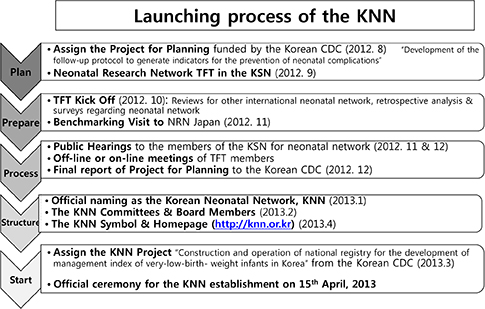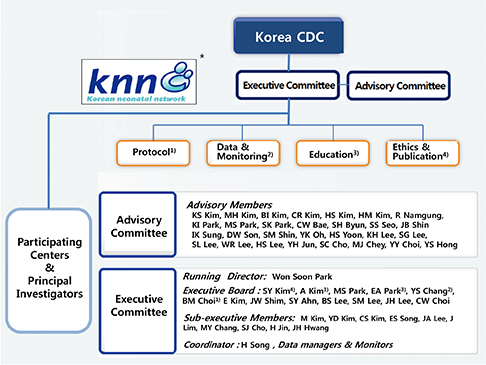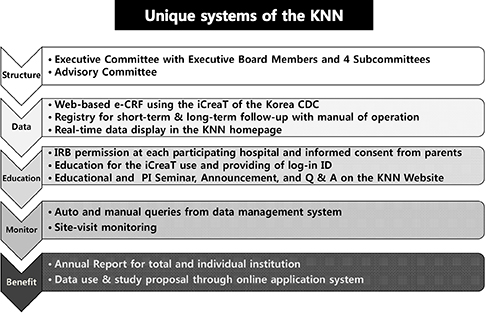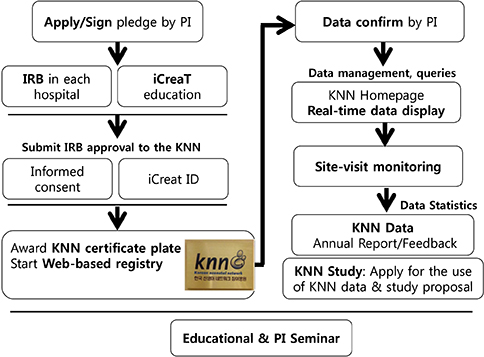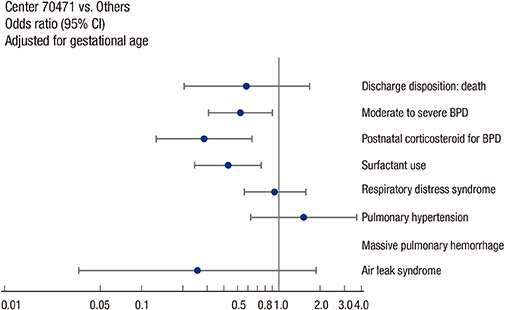The Korean Neonatal Network: An Overview
- Affiliations
-
- 1Department of Pediatrics, Samsung Medical Center, Sungkyunkwan University School of Medicine, Seoul, Korea. wonspark@skku.edu
- 2Division of Cardiovascular and Rare Diseases, the Korea Centers for Disease Control and Prevention, Cheongju, Korea.
- KMID: 2351130
- DOI: http://doi.org/10.3346/jkms.2015.30.S1.S3
Abstract
- Currently, in the Republic of Korea, despite the very-low-birth rate, the birth rate and number of preterm infants are markedly increasing. Neonatal deaths and major complications mostly occur in premature infants, especially very-low-birth-weight infants (VLBWIs). VLBWIs weigh less than 1,500 g at birth and require intensive treatment in a neonatal intensive care unit (NICU). The operation of the Korean Neonatal Network (KNN) officially started on April 15, 2013, by the Korean Society of Neonatology with support from the Korea Centers for Disease Control and Prevention. The KNN is a national multicenter neonatal network based on a prospective web-based registry for VLBWIs. About 2,000 VLBWIs from 60 participating hospital NICUs are registered annually in the KNN. The KNN has built unique systems such as a web-based real-time data display on the web site and a site-visit monitoring system for data quality surveillance. The KNN should be maintained and developed further in order to generate appropriate, population-based, data-driven, health-care policies; facilitate active multicenter neonatal research, including quality improvement of neonatal care; and ultimately lead to improvement in the prognosis of high-risk newborns and subsequent reduction in health-care costs through the development of evidence-based neonatal medicine in Korea.
MeSH Terms
Figure
Cited by 13 articles
-
Moving Forward to Improve Safety and Quality of Neonatal Intensive Care in Korea
Yun Sil Chang
J Korean Med Sci. 2018;33(9):. doi: 10.3346/jkms.2018.33.e89.The Impact of Surgical Intervention on Neurodevelopmental Outcomes in Very Low Birth Weight Infants: a Nationwide Cohort Study in Korea
Se In Sung, Na Hyun Lee, Hyun Ho Kim, Hye Seon Kim, Yea Seul Han, Misun Yang, So Yoon Ahn, Yun Sil Chang, Won Soon Park
J Korean Med Sci. 2019;34(43):. doi: 10.3346/jkms.2019.34.e271.Neonatal Outcomes of Very Low Birth Weight Infants in Korean Neonatal Network from 2013 to 2016
Jang Hoon Lee, O Kyu Noh, Yun Sil Chang,
J Korean Med Sci. 2019;34(5):. doi: 10.3346/jkms.2019.34.e40.The history of neonatology in Korea
Chong-Woo Bae
J Korean Med Assoc. 2016;59(7):490-497. doi: 10.5124/jkma.2016.59.7.490.Past, present, and future of neonatology in Korea
Yun Sil Chang
J Korean Med Assoc. 2016;59(7):487-489. doi: 10.5124/jkma.2016.59.7.487.Future of neonatology in Korea: the way forward
Yun Sil Chang
J Korean Med Assoc. 2016;59(7):506-513. doi: 10.5124/jkma.2016.59.7.506.Changes in neonatal outcomes in Korea
So Young Kim
J Korean Med Assoc. 2016;59(7):498-505. doi: 10.5124/jkma.2016.59.7.498.Trends of Mortality, Time, and Causes of Death in Preterm Infants
Ga Won Jeon
Perinatology. 2019;30(4):221-228. doi: 10.14734/PN.2019.30.4.221.Survival and Morbidities in Infants with Birth Weight Less than 500 g: a Nationwide Cohort Study
Ji Hye Hwang, Euiseok Jung, Byong Sop Lee, Ellen Ai-Rhan Kim, Ki-Soo Kim
J Korean Med Sci. 2021;36(31):e206. doi: 10.3346/jkms.2021.36.e206.Two Year's Long-term Outcomes of Very Low Birth Weight Infants in Korea
Yun Sil Chang
J Korean Med Sci. 2018;33(48):. doi: 10.3346/jkms.2018.33.e294.The Incidence and Survival Rate of Very Low Birth Weight Infants in Korea (2013–2016): A Comparison of the Statistics Korea and the Korean Neonatal Network and Improvements
Jisu Kim, Hye-Eun Kim, Kyung-Suk Lee, Sung-Hoon Chung, Yong-Sung Choi, Chong-Woo Bae, Korean Neonatal Network
Perinatology. 2019;30(1):1-7. doi: 10.14734/PN.2019.30.1.1.Effects of Ponderal Index on Neonatal Mortality and Morbidities in Extremely Premature Infants
Jae Kyoon Hwang, Ha-Na Kang, Ja-Hye Ahn, Hyun Ju Lee, Hyun-Kyung Park, Chang-Ryul Kim
J Korean Med Sci. 2022;37(24):e198. doi: 10.3346/jkms.2022.37.e198.Serial Short-Term Outcomes of Very-Low-Birth-Weight Infants in the Korean Neonatal Network From 2013 to 2020
Ga Won Jeon, Jang Hoon Lee, Minkyung Oh, Yun Sil Chang
J Korean Med Sci. 2022;37(29):e229. doi: 10.3346/jkms.2022.37.e229.
Reference
-
1. Moon JY, Hahn WH, Shim KS, Chang JY, Bae CW. Changes of maternal age distribution in live births and incidence of low birth weight infants in advanced maternal age group in Korea. Korean J Perinatol. 2011; 22:30–36.2. Park YS, Choi SH, Shim KS, Chang JY, Hahn WH, Choi YS, Bae CW. Multiple births conceived by assisted reproductive technology in Korea. Korean J Pediatr. 2010; 53:880–885.3. Astolfi P, De Pasquale A, Zonta L. Late childbearing and its impact on adverse pregnancy outcome: stillbirth, preterm delivery and low birth weight. Rev Epidemiol Sante Publique. 2005; 53:2S97–2S105.4. Mukhopadhaya N, Arulkumaran S. Reproductive outcomes after in-vitro fertilization. Curr Opin Obstet Gynecol. 2007; 19:113–119.5. Bartels DB, Wypij D, Wenzlaff P, Dammann O, Poets CF. Hospital volume and neonatal mortality among very low birth weight infants. Pediatrics. 2006; 117:2206–2214.6. Chung JH, Phibbs CS, Boscardin WJ, Kominski GF, Ortega AN, Needleman J. The effect of neonatal intensive care level and hospital volume on mortality of very low birth weight infants. Med Care. 2010; 48:635–644.7. Chang YS, Ahn SY, Park WS. Committee on Program and Planning and Advisory Committee of Korean Neonatal Network. The Establishment of the Korean Neonatal Network (KNN). Neonatal Med. 2013; 20:169–178.8. Korean Statistical Information Service. Birth Statistics. accessed on 25 April 2015. Available at http://www.kosis.kr.9. Cho JH, Choi SK, Chung SH, Choi YS, Bae CW. Changes in neonatal and perinatal vital statistics during last 3 decades in the Republic of Korea: compared with OECD nations. Neonatal Med. 2013; 20:402–412.10. Hahn WH, Chang JY, Chang YS, Shim KS, Bae CW. Recent trends in neonatal mortality in very low birth weight Korean infants: in comparison with Japan and the USA. J Korean Med Sci. 2011; 26:467–473.11. Shim JW, Kim MJ, Kim EK, Park HK, Song ES, Lee SM, Lee JH, Jin HS, Kim ES, Chang YS. The impact of neonatal care resources on regional variation in neonatal mortality among very low birthweight infants in Korea. Paediatr Perinat Epidemiol. 2013; 27:216–225.12. Choi CW, Kim BI, Kim EK, Song ES, Lee JJ. Incidence of bronchopulmonary dysplasia in Korea. J Korean Med Sci. 2012; 27:914–921.13. Thakkar M, O'Shea M. The role of neonatal networks. Semin Fetal Neonatal Med. 2006; 11:105–110.14. NICHD Neonatal Research Network. accessed on 25 April 2015. Available at https://neonatal.rti.org/.15. Vermont Oxford Neonatal Network (VON). accessed on 25 April 2015. Available at http://www.vtoxford.org.16. Australian and New Zealand Neonatal Network. accessed on 25 April 2015. Available at https://npesu.unsw.edu.au/data-collection/australian-new-zealand-neonatal-network-anznn.17. Canadian Neonatal Network. accessed on 25 April 2015. Available at http://www.canadianneonatalnetwork.org.18. Neonatal Research Network Japan. accessed on 25 April 2015. Available at http://nrn.shiga-med.ac.jp/Englishdefault.htm.19. National Neonatal Audit Programme (NNAP). accessed on 25 April 2015. Available at http://www.rcpch.ac.uk/improving-child-health/quality-improvement-and-clinical-audit/national-neonatal-audit-programme-nn-3.20. Europe Neonatal Network. accessed on 25 April 2015. Available at http://www.euroneonet.eu.21. Park WS. Korean Neonatal Network TFT. Development of the follow-up protocol to generate indicators for the prevention of neonatal complications. 2012 Report of Korea Centers for Disease and Prevention. Seoul: Korea Centers for Disease and Prevention;2012.22. The Executive Committee of Korean Neonatal Network. 2013 Korean Neonatal Network annual report. Seoul: Korea Centers for Disease Control and Prevention;2014.23. The Korea Neonatal Network. accessed on 25 April 2015. Available at http://knn.or.kr.24. Shah PS, Lee SK, Lui K, Sjörs G, Mori R, Reichman B, Håkansson S, Feliciano LS, Modi N, Adams M, et al. International Network for Evaluating Outcomes of Neonates (iNeo). The International Network for Evaluating Outcomes of very low birth weight, very preterm neonates (iNeo): a protocol for collaborative comparisons of international health services for quality improvement in neonatal care. BMC Pediatr. 2014; 14:110.25. Davis JM, Turner MA. Global collaboration to develop new and existing drugs for neonates. JAMA Pediatr. 2015; DOI: 10.1001/jamapediatrics.2015.1640.

